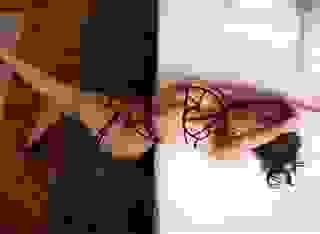- Non-Erotic
- A Boxful of Memories
Note: You can change font size, font face, and turn on dark mode by clicking the "A" icon tab in the Story Info Box.
You can temporarily switch back to a Classic Literotica® experience during our ongoing public Beta testing. Please consider leaving feedback on issues you experience or suggest improvements.
Click here.... A Cache Full of Love
This is a collection of tales and essays about various times of my life.
The stars have always intrigued me. As a child, I would prop up my father's old beach chair on our front lawn in the early evening, a bag of dried watermelon seeds in hand. I would spend hours looking up at the dark mantle above me, snacking on the seeds, dazzled by the bright pinpoints generously strewn across the black expanse above me. I was fortunate because progress had not yet reached our tiny village back then, and I was afforded an unobstructed view of the evening sky with no skyscrapers and elevated highways to mar the sight, no tall halogen lamp posts or neon billboards to dull the astral glimmer.
The stars were magical fireflies, older than time, that came out at night to frolic... and chatter. The galaxy was their inky playground; and they told stories in shimmering, pulsing -- and endless gyrations: there was the grieving princess who lost her dearest love; she would cast the gems from her crown at night, strewing them across the sky, hoping their jeweled brightness would lead her beloved back to her. There was the evil sorcerer whose captives were only allowed a glimpse of freedom at sunset, their eyes blinking sadly down from the blackened heavens above.
But like all childhood fancies, my star gazing came to an end, the magic that I once found in it, lost in the inevitable journey of growing up. The stories, too, changed as the accumulated knowledge of life turned them from the enchanted -- to the mundane. The princess' lost love never found his way back to her; along the journey home, he fell into a more elemental world, and his attention turned from romance to long charts peppered with short letters whose meanings he found more attractive to decipher: C,Al2O3,Be3Al2(SiO3)6. The princess grew tired of casting her gemstones every night and took up knitting. The lost souls never escaped, but found contentment and salvation in studying theology, while the sorcerer realized the evil of his ways and, remorseful, retired from wizardry and became a high school principal.
The stars are still there, of course, safe in the night sky. And though they still pulse and gyrate, they are mostly quiet. But once in a while, when I start forgetting what it was like to be young, I recall their stories once again and I am transported back to the front lawn, sitting in a battered beach chair, munching on a bag of watermelon seeds and gazing up in awe at the soaring fireflies, as they flit from the nest of my imagination to the night sky above.
I can still see him, Manong Lucio, the ice cream vendor who was only allowed to enter the school grounds twice each day, eleven in the morning and half past three every afternoon. The times coincided with lunch at and dismissal from the all-girls Catholic school where I studied.
Manong Lucio had the kindest smile and his skin was burnt to an even brown by a lifetime of pushing his ice cream cart and selling the treats we thought were the nearest thing to heaven then; cold sweet delights that tickled the palate and went down our throats so smoothly that we could never have enough, we spent half of our daily allowances on them! And that was quite the sin back then, since most of us had packed meals made by loving mothers, who made sure that our lunch boxes included healthy snacks and desserts like bananas and dalanghitas, the native oranges.
We were devoted to Manong Lucio and the seemingly endless selection of ice-cream flavors in his cart. He had chocolate and vanilla, of course, what ice cream cart would not? After all, we thought ourselves very American back then and it just wasn't done to not include these in any soda fountain menu, even if the soda fountain was more akin to a large box set on two large wheels. However, it was the more native offerings we were after: the queso ice cream Manong Lucio sold had huge chunks of cheese mixed in and after finishing off two scoops of this, there simply was no room left for a healthy dessert, nor lunch, for that matter, I usually had my ice cream before anything else! He also had the sorbetes de ube - a creamy violet colored sorbet made from the purple yam, and an ice sherbet of sugar apple which was so sweet that my grandfather once used it to flavor his coffee!
Then there was the mango ice cream which, in true Filipino fashion, had bits of the fruit swimming within the frozen creamy swirls. There are no words to describe the taste of the Philippine mango, and I don't mean the dried variety that my country exports; it is, quite simply, the best mango... ever.
After deciding on the flavors came the choosing of the vehicle which would hold the ice cream and transport it to our impatient palates and Manong Lucio had a variety of those, too. Aside from the usual wafer cups, he had the sugar cones which, though smaller, were crunchier. It also took longer for these to turn soggy under the ice cream and we tried to keep from biting into these crunchy cones until we had licked all the ice cream off. Why? Because, kind-hearted Manong Lucio was never averse to giving an extra scoop as a free refill.
And on really special days, we could splurge on the pan de sal small baked bread buns, which, when filled with ice cream, was a meal by itself. My mother never quite believed my explanations when I came home with an untouched lunch, but neither did she stop giving me pocket money, although she knew that most of it would end up in Mang Lucio's ice cream cart.
I am far removed from that time now, those days when my friends and I counted ice cream money instead of calories, and it has been decades since I last saw and had queso ice cream and sorbetes de ube from an ice cream cart. But on the occasions when I throw caution to the wind and allow myself a cone, I still hold off from biting into it, keeping the crunchy treat whole until that last final lick, not because I expect a refill, but more in tribute to Manong Lucio, whose kindness was, perhaps, the best of all the treats he offered.
I am a creature of warmth and water and ever since I can remember, I have been browned by the sun during the summer months, and bathed by rainfall during the monsoon. Nurtured thus by dry and damp, I have learned to color life using the cycles of blue skies and grey: mirth and lightness are tinted blue, while heaviness, both of the body and the soul, are inevitably tinged with grey.
I have yet to awaken to a morning in spring and I have never slept through a winter evening. Numbing cold is foreign to me, and sleet and ice and snow are words I have seen only on paper. I cannot imagine a field clothed only in white or trees naked of green. I have seen these only in photographs, but they have been enough to convince me that I will not thrive in such a clime. It is a pity, for when I was young, and like every child the world over, I did dream of Santa and white Christmases.
My world is that of unforgiving sun and relentless rain, a blinding swathe of brilliant gold and an unmerciful cloak of wet shadows. Because of the heat of the summers I have sweated in, and because of the floods that I have waded through during the monsoon, I have forged a relationship with warmth and water that is almost maternal, and certainly respectful, for they are both the beginning and the end of the cycles of the life I was born into. The cycles of your life are probably different and more varied than mine. Whatever they may be, I hope they are kinder and gentler, and the colors that you choose to paint them in as vivid as your dreams.
Jamon de Piña is the crowning glory of the Noche Buena feast in most Filipino homes, it is a leg of ham, roasted or baked, and the Christmas Eve midnight repast is never complete, unless this dish is found in the very center of the table. It was the same in my home, but my brothers and I looked forward more to the cooking of the ham than the eating of it; in fact, it was the most awaited ritual of the Christmases of my youth, and we looked forward to it more than opening our presents under the tree.
My grandfather, Lolo, was in charge of the whole production, for that was what it was -- a grand almost theatrical culinary presentation. He would buy the raw air-dried ham a week before Christmas day, usually in Binondo, the Chinese quarter of Old Manila, where one could buy anything under the sun. The ham had to weigh more than three kilos, for it was sure to shrink by the time it was fully cooked. Now I have seen Spanish and Italian and French legs of ham, but the one we call Chinese ham (I suppose because we bought it from the Chinese merchants) is vastly different from the European varieties, it is extremely dry and smells like baby powder and vinegar, the skin is caked with salt -- and a thin veneer of mold! After buying the ham, we would go to the Chinese grocer's where Lolo would purchase several liters of pure pineapple juice and the largest empty can of lard the grocer had for this was where the ham would be cooked in.
The day before Christmas was when the show really got started. Right after breakfast, my grandfather started working on the leg of ham, peeling the salty, moldy outer rind and scraping every bit of the green stuff off until the white fat under the skin was exposed, then he would rub the whole leg with brown sugar and leave it on the dinner table to start the fire in the backyard. He'd pile short branches of wood (we still had fruit trees in our yard back then) which he had dried over several months, and around the wood he would place four slabs of adobe. Once this was done, he would set fire to the wood. After this, the large can of lard was filled with sweetened pineapple juice, cloves and oregano, then placed over the fire, an extra two or three liters of juice was always on hand to replenish the liquid cooking in the can. Lolo always waited ten minutes before immersing the leg of ham into the fragrant mixture. My brothers and I would take turns fanning the fire to keep the temperature high and even. We did this until our arms ached, while our grandfather would regale us with tales of his youth, a lot of which were stories about the spirits and strange creatures of the night who inhabited the land when there were still no cities.
No matter how early the cooking started, it would be dark before the ham was pronounced done. By this time, everyone was just aching for a taste of the ham and all fears of too much salt -- and mold -- had been banished. But Lolo was not quite done yet. It was time for the piece de resistance: once the ham, now moist and tender, was removed from the can and placed on a large platter, the whole ham was topped with a thick coat of brown sugar. Then he would take an ancient cast iron turner, which we call siansi, place it in the still roaring fire until the flat side turned red hot. Then he would gently place the heated turner on the brown sugar, caramelizing it and filling the whole house with candied fragrance (to this day I believe that heaven must smell like caramelized brown sugar.) He would repeat the process until the whole ham was fully coated with the ever so slightly burnt sugary sweetness. And with that untoppable encore, we would sit down at the Noche Buena table to begin the feasting.
My country has its share of monster folklore: ogres, demons and creatures of the night, frightening beings whose terrible tales of retribution were often told to children who were labeled 'difficult', only because they were inordinately stubborn and did not relish the thought of going to bed at the appointed hour. I thought that these stories had been buried, along with the jack-stones, toy pots and pans and Chinese garters of my youth, but I was wrong. They have achieved a surprising renaissance....in real life.
The favorite and most famous monster in the tales is the capre. He is described as a very huge ogre of a man, with long dark bristly hair all over his body, red rimmed eyes, and large yellow teeth. His favorite past time is to climb the nearest tree to one's bedroom window, where he will sit all night -- smoking a very large cigar! This would explain the red eyes and yellow teeth, as well as the foul odor he reeks of. The creature also has a penchant for pulling the blankets and covers from the poor hapless souls sleeping within a house. It has never been explained why he does this, it was only when my brothers and I were in our teens that we realized that the capre was something of a voyeur. Today this monster would probably be sitting up all night, not in a tree, but in front of a pc.
A pair of popular monsters are the aswang and the manananggal -- female creatures of the night, shape-shifters whose appearance and m.o. resemble that of the western vampire. If the capre is the most popular brute, the aswang and manananggal are the most feared, for their very names are synonymous with death. They feed on blood (of course) but their favorite prey are unborn children. It is said that they will lie in wait on the rooftop of a pregnant woman's house, wait for her to fall asleep and once she had, would suck the baby's lifeblood from the mother-to-be's belly with thin straw-like tongues! This ghastly diet ensures their eternal youth and beauty. These days we would, no doubt, find this fiendish pair waiting for their placenta injections at the nearest trendy spa.
The third horrible beast is the buwaya, (the salt-water crocodile in English)a creature very much feared, although, quite a newcomer to the list of my country's monsters and ogres. There are two horrible realizations you should know about the buwaya: 1) it is a real beast. It grows extremely large in my country. The biggest one ever caught was captured some years ago in Agusan del Sur. Measuring 20 feet and 3 inches, it took over 100 people to bring him onto land and is suspected of eating not just several water buffaloes, but a farmer and a 12 year old girl as well. Lolong (grandfather), as the beast was called, was estimated to be fifty years old and there very well may be older -- and much bigger -- giant buwayas along the marshes of Agusan.
And the second realization? Ah, there is a new breed of crocodiles in my country. They are a hybrid of sorts, for they possess the hunger and greed of the crocodile: they feast on my country's livelihood (much like Lolong did on the farmer and the water buffaloes), and eat away at the youth of my land and their dreams. The only difference is that these hybrids walk on two legs, have money and power, and are often elected to the highest seats of government.
I learned today that the small house where my brothers and I spent our early years was finally torn down. I suppose it was about time -- it was already a very old house, even before my family moved in -- and it stood in a small community, in a small district, in a small town.
The house of my memory was the first shelter I ever knew, the first address to which I moved after leaving the hospital where I was birthed -- it was where I had my first home-coming, in a way. It was witness to the first, in a long line, of my mother's sleepless nights, when bedding down was accompanied by cloth diapers and blankets and pins and towels and wraps. But my mother counted herself lucky in that she breast-fed all of her children and, thus, never needed to rest within reach of a baby bottle.
The house of my memory was where I first took a tumble, and where I first learned to walk and eventually... run. Naturally, running led to falling -- again -- and again. I still stumble to this day, but the tumbles I am prone to now have nothing to do with running. The house saw me through the trappings of my first birthday party, my first Christmas get-together and my first New Year's Eve.
I remember the field just outside the house of my memory. It served as the first playground for my brothers and me, as well as for the other children of that little town. It was where I learned to play the games of my childhood -- pico (hopscotch), taguan (hide and seek), bahay-bahayan (play house), dyakstones (jack-stones, the letter 'j' was not, at that time, part of the Filipino alphabet), patintero (a sort of organized game of group tag) and Chinese garter (which involved jumping over a stretched string that was held higher at every turn.) The field was surrounded by Jamican cherry trees, called aratiles in Filipino. Their fruits resembled rubies when they ripened, and the girls would smear the juices on their lips because it made them look like they were wearing lipstick. The boys, in turn, would capture and harness the huge spiders whose webs dangled from the branches, for 'spider-fights.' I am sure that more than a few of those same boys graduated to breeding fighting cocks in later life. My brothers and I headed off for that expanse of youthful freedom right after breakfast. We spent the better part of the day playing under a sun that was kinder back then, and went home grudgingly -- it was a betrayal of sorts, to leave when there was still a tiny bit of sunlight left.
Neighbors knew each other in our little community, the 'hometown' of my memory. It was not a wealthy town, far from it, but everyone was willing to share what they had. And they shared more than the material -- they shared in the joy and good fortune that occasionally came, and they shared in the pain and misery, which was doled out more often by fate and the 'bad spirits' that were ever present, but hinted of only in whispers, lest breathing their un-nameable names would conjure their horrible likenesses physically; no one ever saw them, as far as I can remember, which begs for an explanation as to how horrible-looking they really were.
Nothing is left now of that small town, nor the field of my youth. They fell prey to ever changing zoning rules and 'appropriation laws' penned by groups of very smart government officials whose names, again, were never mentioned and whose faces, again, we never saw; I still carry the childhood notion that anyone in government must have some bit of monster in their DNA.
And today the house that I remember no longer stands. It was old and small, nondescript, insignificant, almost forgettable; but my memories of it will forever be renewed... and they will always be grand.
- COMMENTS
*****That was really a enjoyable read. It took me back to days long ago. Thanks for sharing.
Growing up in central Kansas was not that much different. Except for the crocodiles...........
5 Stars, loved every bit of it!
Would love to see some horror stories from you about the buwaya, aswang and the manananggal OR the capre. I really like the capre. He sounds like my Father.
Thank you so much for the kind and generous comments; they have truly lifted my heart and soul, making me think that, perhaps, I was not wrong to start writing again.








